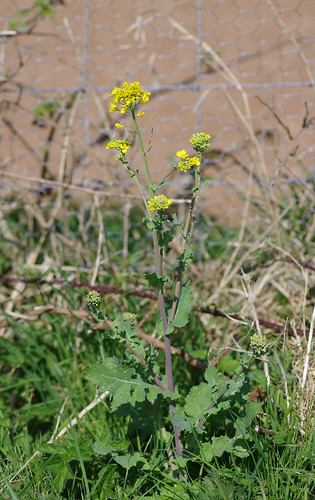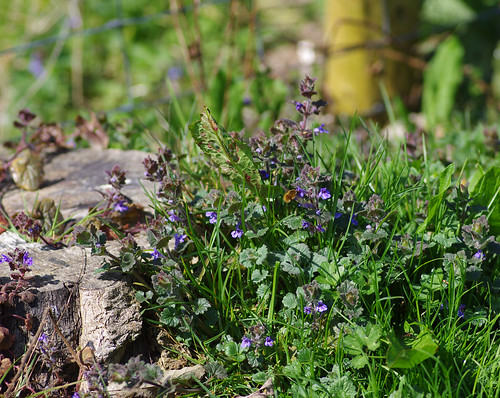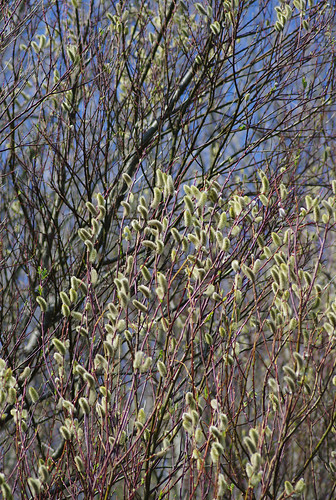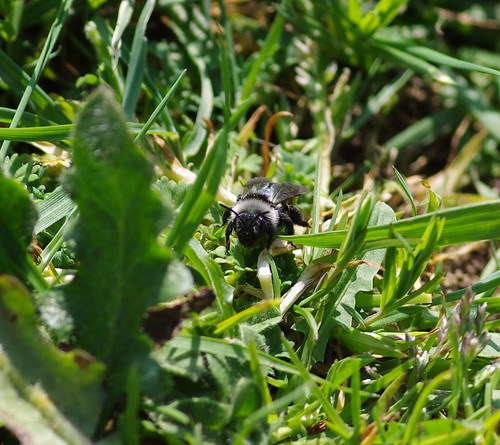On the Coast Path again betwixt Brixham and Kingswear
Down the lane from Coleton Barton Car Park, we pass the Day Beacon, known locally by some as 'the Daymark'. I'm not sure how or why the name came about. The Tower (as it is labelled on the OS map) was built in 1864. It was intended as a navigation aid for ships at sea. There is a short footpath intersecting the field. Standing inside the six-sided stone structure and gazing up at the sky is a memorable experience, particularly when the winds whip in all directions through the arches.
Today, we walk on and admire the landmark from below. The sky is an unbroken canvas of blue, the field has been ploughed and is uniformly dusty brown with small ridges curving to the right. And between field and sky, the Daymark pokes out of the hedge.

The Daymark
We descend the lane and turn left off it just before the Coastwatch Station. Spring is in full swing and the ground is busy with invertebrates but something else draws us in; something above our heads.

Male flowers of a pine tree.
It's funny how you often see things without appreciating their worth. I must have passed scores of pine trees like this and not paid the flowers much attention. Sherry stood snapping away and moved round to get them in a better light.

We're not sure which species of Pine these flowers belong to. We will have to return later in the year to look for the cones and conduct a more detailed investigation. Being not scientifically trained in any shape or form, I often find I lose all sense of perspective and my mind is prone to wander as much as my feet!
We did have a route in mind, though, keeping left on the high ground and our eyes peeled.

Wild Turnip (Brassica rapa)
Brassicas can be a minefield for the uninitiated. I'm not pretending to be an expert here. I don't think I ever will be, either. Whenever I see a brassica I'm perpetually doubtful what it could be. At first I thought the flower above might be Charlock - influenced by one of the field guides telling me Charlock often has reddish stems. But then again... The shape of the leaves doesn't match and looking at an image of a wild turnip leaf I noticed the same spot pattern. So it must be Brassica rapa...
I think that soon I will have to take the botany part more seriously. A good loupe is what I need, as well as an unlimited stock of patience. Trying to identify anything is a discipline. If you don't keep your eye in and practice all is lost. It's only by repeated observation that you gradually glean knowledge and learn from your mistakes, accepting that no-one can ever be perfect. Being flawed is what makes us human. And if we had all the answers life would soon lose its fascination.
We move along outside the field borders and then turn to the grassland. Daisies are abundant and there is Ground-ivy aplenty.

Ground-ivy (Glechoma hederacea)
Ground-ivy can grow in isolation among the grasses or in dense clusters. Just to the right of the middle of this picture one flower is being pollinated by a Bee-fly. Over hill and a dried-up stream, we look to catkins swaying in the breeze.


Catkin Clusters
These trees were arranged in a strip bordering a field. Sherry managed to capture both the texture and a dynamic sense of movement. It's only a short circuit for us today but even then it seems there is so much to see we might not be able to record it all.

Scots Pine cone from below
We were both actually in the tree for this one. The Pentax got the crisp, clear light and the bokeh has sparkle while still being dreamy. After this foray away from the main path we venture down to join it. On the ground there's a strange puffball that looks like a jacket potato skin filled with brown fluff. Before Pudcombe Cove, we leave the coast path behind, by setting an intended course inland and back to Coleton Barton.
But first lunch beckons. I became a bit edgy and pace around holding my sandwich because I can't settle. A bee buzzes around me constantly. Sherry soon detects the problem and provides a solution. It's the water container for the dog. The bee must be thirsty. I guess insects have to drink just like everything (and everyone) else. A few drops on the ground does the trick. But capturing the bee on camera proves somewhat more problematic.

The Ashy Mining-bee (Andrena cineraria)
At least we think it is. Please note that the picture has had to be heavily cropped. It was hot and after being refreshed the bee did not plan on sticking around and being one of our subjects. Our route went over a stile and led along the left side of a field, past another unsolvable dilemma.

These flowers are either a species of Chickweed or Mouse-Ear. But I think I've scratched my head enough for one entry. I'll go straight through the scalp one of these days. Until next time...

Comments
Add a Comment